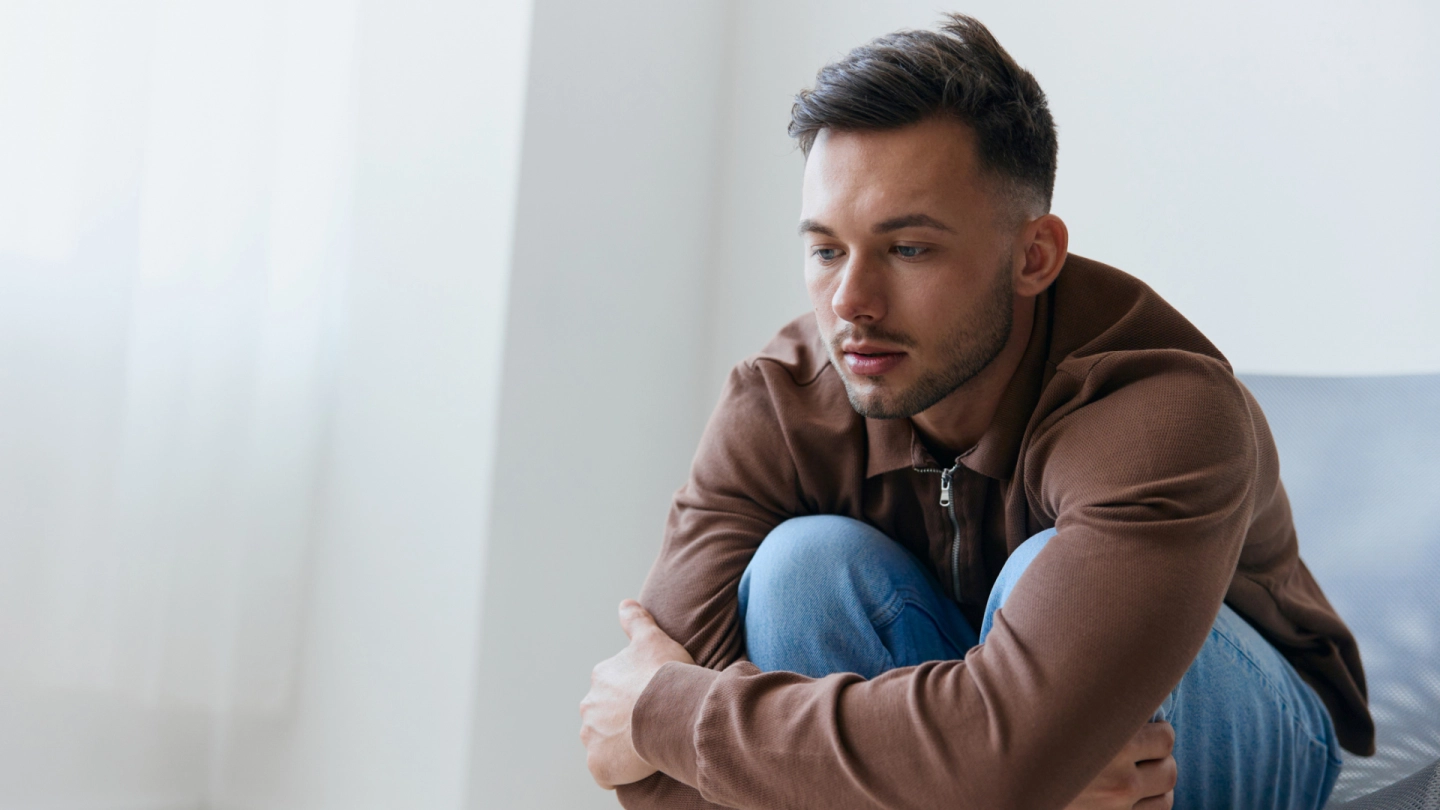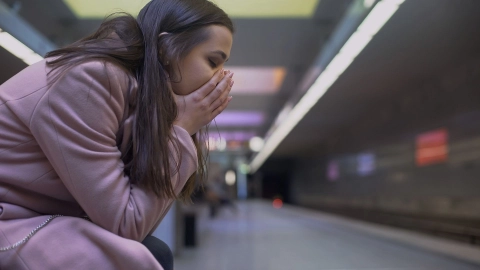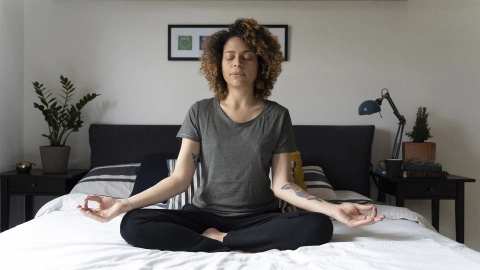Healthy living Coping with anxiety
Anxiety and panic can have a major impact on a person’s life. Short-term relief from anxiety occurs when fears can be avoided and fearful situations come to an end. However, avoidance perpetuates anxiety in the long run and places further limitations on life. The solution usually lies in facing one’s fears.
At a glance
- Fear warns people of danger. It sets in motion bodily responses that provide energy for a “flight or flight” response.
- Some people experience recurrent panic even though there is no danger at all.
- In the vicious cycle of fear, anxiety increases as the body reacts to things it sees as danger.
- Avoiding fearful situations leads to short-term relief, but intensifies fears in the long run.
- For many, facing fears helps.
- If fears severely limit a person’s life, one should seek professional support.
Note: The information in this article cannot and should not replace a medical consultation and must not be used for self-diagnosis or treatment.

What are anxiety and panic?
Fear warns people of danger and can be an extremely unpleasant, threatening feeling. But without fear, people would not have survived over time, because a person who feels no fear does not recognize danger.
When a person reacts in fear, processes are set in motion in the body that very quickly provide energy to the person to respond to the danger: to either fight or flee. Stress hormones such as adrenaline are released for this purpose. They cause the heart to beat faster in order to supply the muscles with oxygen-rich blood. Sweating and discomfort are also part of this reaction. Organs not needed for an escape or attack response receive less blood flow. This includes, for example, the digestive system.
One type of fear is that when concrete dangers, such as fire, the smell of gas, or dangerous animals are present. However, a person can experience fear even when there is no actual danger. This type of fear includes, for example, exaggerated fear of negative judgment by other people or the ongoing fear of a severe illness even when test results come back negative.
This article specifically addresses panic. Panic is a very intense form of fear of a presumed or actual threat.
When does anxiety become stressful?
Some people often experience “false alarms”. They have distressing feelings of anxiety even though there is no acute danger. Anxiety can range from mild restlessness to complete panic.
Panic usually occurs suddenly and lasts for a limited amount of time. In general, acute panic is about the fear of dying or losing control over mind and body. After an initial panic attack, many sufferers fear that the panic will occur again. They become afraid of the fear.
When worry, nervousness, or panic interferes with life for an extended period of time, a generalized anxiety disorder or panic disorder may be present.
Video What is generalized anxiety disorder?
This video explains more about the symptoms and treatment options for generalized anxiety disorder.
This and other videos can also be found on YouTube
Watch nowThe privacy policy indicated there applies.
What is the vicious circle of anxiety?
Sometimes bodily sensations, thoughts, feelings, and physical reactions mutually reinforce one another within a short period of time, and anxiety increases and creates a kind of vicious circle.
For example, a person goes shopping in a department store and it becomes more and more crowded. He or she is getting warmer and warmer and perceives he/she is starting to sweat. This triggers the thought, “I’m suddenly sweating so much. There must be something wrong with me”, and the person gets scared.
The fear sets off changes in the body, for example, the release of stress hormones. As a result, the pulse increases. The person now notices a rapid pulse and pressure in the chest and thinks, “I’m going to have a heart attack!”
The anxiety now increases rapidly, hormones are released faster, and the pulse seems to be racing. The chest becomes tighter and tighter. The person panics.
What effect does avoiding fearful situations have?
As a rule, people tend to avoid unpleasant things. A person who has experienced panic in a certain place or situation may avoid that situation or place in the future. A person might have a fear of certain things or creatures, for example, syringes or spiders, and then avoid these “objects”.
If the person tries to approach the situation or object, they may flee at the first sign of anxiety. They fear that the severe anxiety or panic will repeat itself and that this will pose an acute threat, even if the place, object, or situation poses no danger.
In the short term, escape brings relief and anxiety decreases. Several factors determine whether avoiding the feared places, things, and situations can be a solution. One factor is how dependent the person is on the places or objects they avoid out of fear: in Europe, people may be able to live well with a fear of snakes because they are rare. On the other hand, it is more difficult if one is afraid of syringes, supermarkets, or riding the train.
Furthermore, fears may spread from one feared situation to other situations, for example, from department stores to supermarkets. It may be possible to avoid these situations, but life also becomes increasingly restricted as a result.
What are specific ways to cope with anxiety?
It is important to do something about fear, because fears rarely disappear on their own.
Assess the danger
In the long run, avoidance often leads to limitations and confirms fearful thoughts. Therefore, it is an important goal to face the fear. An important question in this context is whether there is really a heightened danger in the situations that are being avoided.
If a person is concerned about serious illness during a panic attack, they should be examined by a physician. In this way, it is possible to find out whether there really is an increased risk.
Accept minimal risk
There is no such thing as 100 percent certainty in life: in theory, bad things can happen at any time. Because of this, some people want to withdraw completely from life for safety’s sake. But withdrawing to a great extent increases the risk of becoming ill, for example through lack of exercise and social isolation. It is healthy and reasonable to accept that a small amount of risk is part of life, and not to be limited by this small risk.
Facing fears
If a medical examination indicates that someone is physically healthy, then there is no reason for them not to face a non-threatening but feared situation. This approach is also called confrontation or exposure. It may be sufficient in some cases to imagine or look at a picture of the feared object or situation. But why would someone intentionally enter a situation that causes them great fear?
In answering this question, five assumptions play an important role, which at the same time describe how to confront fear:
- The fearful thought of being in acute danger does not correspond to reality.
- The situation can be endured without causing long-term physical or psychological harm.
- By enduring the situation and the fear, the person can experience how the fear subsides on its own. Usually this happens after 5 to 30 minutes.
- The situation, place, object, and fear itself are no longer frightening.
- The person can go into the previously avoided situations or face these things again (almost) without feeling fear.
In summary, by confronting their fear, people learn that neither the situation, place, thing, nor fear itself is dangerous. Fears continue to diminish the more often one confronts them. The fear subsides on its own and the person eventually no longer associates the situations, things, or places with fear. In this way, confrontation can help overcome fears and live with more freedom again.
What strategies help prevent panic attacks?
A daily life filled with high levels of stress and pressure can make people more susceptible to panic attacks. With the exception of people who lack anxiety due to illness, everyone has a personal anxiety threshold. When this threshold is reached, it becomes stressful and the vicious cycle of anxiety can be set in motion. Everyday stresses do not cause the anxiety threshold to be crossed when tension is generally low. However, for some people who are “vulnerable” to anxiety, this threshold may be crossed after severe stress, such as the death of a loved one or a serious accident.
However, the general level of stress can increase to high levels, for example, due to unemployment or social isolation. When this happens to people who are vulnerable to anxiety, it can have serious consequences because everyday stresses, such as an argument or small mishaps, can lead to the anxiety threshold being exceeded. Under these conditions, severe anxiety or panic can occur more frequently in everyday life.
An example can illustrate this well. If a person standing in the sea up to his ankles (low stress), a big wave (stressor) must come in order for his knees (anxiety threshold) to get wet. But if they are already standing in water up to the calves (high stress), then the knees get wet even when small waves (everyday stressor) appear, and panic occurs more frequently.
Reducing tension and stress in everyday life
So, to be less prone to anxiety and panic, it is helpful to reduce tension and stress in everyday life. There are several ways to do this.
- Relaxation methods can be effective for reducing anxiety and stress. One well-known form of relaxation is the Jacobson progressive muscle relaxation (PMR) technique. This involves first tensing and then relaxing different muscle parts in succession.
- Sports and exercise also help to reduce stress and tension.
- Yoga, meditation, and mindfulness exercises involve movement, breathing techniques, and mindfulness exercises. These practices can also help reduce stress. An important element of the practice is acceptance: accepting things when they cannot be changed.
- In addition, it is important to maintain a healthy lifestyle. This includes eating a balanced diet, getting enough sleep, minimizing alcohol and caffeine intake, and abstaining from tobacco and other drugs.
- It is also helpful to complete tasks according to importance and to create weekly plans with realistic goals.
- In addition, it helps many people to actively address conflicts with others and resolve them.
- Finally, stress can be reduced by knowing one’s own limits and setting boundaries.
What thoughts help to cope with anxiety?
Below are a few more thoughts that can help people with various fears:
- My physical sensations are not absolute proof of impending disaster.
- I allow for the possibility that I have misinterpreted my physical sensations as danger.
- It is possible that fear is the reason for my physical reaction.
- The fear itself is harmless and will pass.
When is therapy necessary for anxiety?
If one or more of the following statements apply, seek professional help from a psychotherapist or psychiatrist.
- I think about my anxiety more than half the day.
- I am considerably restricted in my quality of life and freedom of movement by my fears.
- Because of my anxiety, I am becoming more and more depressed.
- I have had suicidal thoughts because of my fears.
- I often cope with my fears through alcohol, drugs, or tranquilizers.
- Because of my fears, my relationship or my job is in serious danger.
Important: If you are unsure whether psychotherapy, medication, or a combination of both would help you cope with your anxiety, talk to your family doctor.
Where is psychotherapy available?
Local psychotherapists and psychiatrists can be found through the Associations of Statutory Health Insurance Physicians (Kassenärztliche Vereinigungen – KV). Call 116 117 or use the online directory for physicians.
For more information about finding a psychotherapist and understanding emotional stress, visit the website Wege zur Psychotherapie (Pathways to Psychotherapy) operated by the Chamber of Psychotherapists.
- Deutsche Gesellschaft für Psychiatrie und Psychotherapie, Psychosomatik und Nervenheilkunde e. V. (DGPPN). Behandlung von Angststörungen – Langfassung. S3-Leitlinie. AWMF-Registernummer 051 - 028. 04.2014.
- Deutsche Gesellschaft für Psychiatrie und Psychotherapie, Psychosomatik und Nervenheilkunde e. V. (DGPPN). Behandlung von Angststörungen. S3-Patientenleitlinie. AWMF-Registernummer 051 - 028. 10.2014.
- Bassam K et al. Mindfulness-based stress reduction for healthy individuals: A meta-analysis. Journal of Psychosomatic Research 2015. 78: 519-528. doi: 10.1016/j.jpsychores.2015.03.009.
- Margraf & Schneider. Lehrbuch der Verhaltenstherapie, Band 2. Kapitel 1, 2 und 5. Springer: Heidelberg 2009.
- Miko HC et al. Auswirkungen von Bewegung auf die Gesundheit [Effects of Physical Activity on Health]. Gesundheitswesen (Bundesverband der Ärzte des Öffentlichen Gesundheitsdienstes (Germany) 2020. 82: 184–195. doi: 10.1055/a-1217-0549.
- Montero-Marin J et al. Is cognitive-behavioural therapy more effective than relaxation therapy in the treatment of anxiety disorders? A meta-analysis. Psychological Medicine 2018. 48: 1427-1436. DOI: 10.1017/S0033291717003099.
- Pascoe MC et al. Yoga, mindfulness-based stress reduction and stress-related physiological measures: A meta-analysis,
Psychoneuroendocrinology 2017. 86: 152-168. DOI: 10.1016/j.psyneuen.2017.08.008. - Ströhle A, Gensichen J, Domschke K. The Diagnosis and Treatment of Anxiety Disorders. Dtsch Arztebl Int. 2018. 155(37): 611-620. doi: 10.3238/arztebl.2018.0611.
Reviewed by the German Association for Psychiatry, Psychotherapy and Psychosomatics (Deutsche Gesellschaft für Psychiatrie und Psychotherapie, Psychosomatik und Nervenheilkunde e. V.) (DGPPN).
As at:





